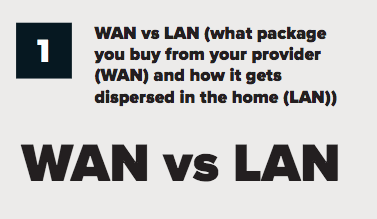Going into the remote work/E-Learning stage that we’re all in right now, the number one concern I’ve heard is, “I wonder if I’ll need more internet for all this.”
It’s not surprising that people don’t know the answer, but with a little information, you can pretty easily assess your needs.
First, we need to talk about the “two sides” of the Internet. I’m talking about your Wide Area Network, or Wan connection, versus your Local Area Network or LAN connection. They’re very different things, but both are important when setting expectations for performance.
Your WAN connection is what you’re going to buy from your internet provider. You might have 10Mb or 25Mb or 100Mb or even 1000Mb (which is a Gb or gig of internet). No matter how many people or devices you have in your home, you never have more capacity than the WAN connection you’re buying from your provider.
Your WAN connection plugs in or “terminates” in your home router. That may be a piece of equipment your service provider owns, or it may be something you own. But that’s the device where the handoff between the WAN and the LAN takes place.
Your LAN, then, is the other side of the internet. You may plug a computer or gaming console into your router, or you may connect to your router via Wi-Fi. The biggest things to consider with your Wi-Fi plan are coverage and interference.
Regarding coverage: For many homes, a single router works just fine and provides adequate coverage to all corners of the house. If you’ve got a very large house, or very insulated walls or any number of other factors that may inhibit Wi-Fi signals, you may need to consider a second access point or a Wi-Fi mesh system.
Quick Tips




Regarding interference: We don’t see this as much as we used to, especially with more and more dual-band routers in the market, but sometimes we can still have problems with Wi-Fi interference in apartments and dorm rooms. When you get so many routers all trying to broadcast on the same Wi-Fi channels, that can cause interference. Devices may lose connectivity in these cases. Dual-band routers almost always work better in these situations, but it’s important to note that dual-band router signals may not travel as far.
Now that we understand a little more about WAN/LAN let’s talk about your actual needs.
Most home Internet plans have different download and upload rates. You may subscribe to a plan that has 100Mb down but only 10Mb up. And in most cases, that works just fine. For normal life, you’re doing more downloading than you are uploading. Think of watching a movie on something like Netflix. You’re downloading that content from their most local servers. For high-definition you need about 5Mb down. For 4k, you need 25Mb down. If you’re the one providing the content, though, if you’re the one providing the content, though, if you’re doing two-way video, then your needs switch. You need both download AND upload if you’re going to do it in high definition and high quality. If you only have 10Mb up, you can see where you might run into badwith trouble in a hurry if you, your spouse, and your student are all trying to videoconference at the same time.
Now, that said, the programs we’re all using do a pretty good job of scaling back the video to use the available bandwidth, so I’m not saying your calls are guaranteed to fail. But you do need to go into your days with eyes wide open.
Do the math. Review your bill to verify the speed of your Internet package. Look at everyone’s schedules. When do you all have calls? What’s your total available bandwidth
If you need to upgrade, talk to your provider. If you need to coordinate better with your family members, try that.
It’s all about understanding what you have and what you need.
I hope this helps you be safe and work well.








